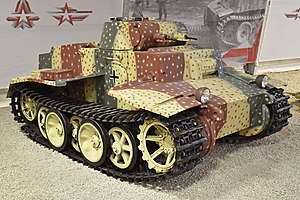Panzer I Ausf. F
This article needs additional citations for verification. (January 2024) |
| Panzerkampfwagen I Ausf. F | |
|---|---|
 Pz.Kpfw. I Ausf. F in Kubinka Tank Museum | |
| Type | Light tank |
| Place of origin | Germany |
| Service history | |
| In service | 1942–1944 |
| Used by | Nazi Germany |
| Wars | World War II |
| Production history | |
| Designed | 1941–1942 |
| Manufacturer | Krauss-Maffei |
| Produced | 1942 |
| No. built | 30 produced |
| Specifications | |
| Mass | 21 long tons (21 t; 24 short tons) |
| Length | 4.375 m (14 ft 4.2 in) |
| Width | 2.640 m (8 ft 7.9 in) |
| Height | 2.050 m (6 ft 8.7 in) |
| Crew | 2: commander and driver |
| Armor | 20–80 mm (0.79–3.15 in) |
Main armament | 2 × 7.92 mm MG-34 |
| Engine | HL 45P 6-cylinder 150 hp (110 kW) |
| Power/weight | 7.1 |
| Suspension | Individual torsion bar |
Operational range | 150 km (93 mi) on-road; 110 km (68 mi) off-road. |
| Maximum speed | 25 km/h (16 mph) |
The Panzerkampfwagen I Ausf. F, also known as VK 18.01, was a German light tank from World War II. Despite the fact that it was designated as a modification of the Panzer I light tank, the VK 18.01 was a completely new vehicle that almost nothing to do with other Panzer I variants.[citation needed] The Pz.Kpfw.I Ausf.F was created in 1942 as a light tank designed to storm fortified lines. In that same year, 30 units were produced (No. 150301-150330). From 1943 it was used for anti-guerrilla operations on the Eastern Front and in Yugoslavia. Thirty Panzer I Ausf. F tanks were built between April and December 1942, eight of which were sent to the Eastern Front for evaluation.[1]
The Pz.Kpfw.I Ausf.F was almost the same as the Panzer II Ausf. J in terms of armor, which itself did not enter serial production.
History
[edit]Since the end of 1938, the German army leadership knew that the Panzer I no longer had any potential as a combat tank and all new developments were directed towards reconnaissance or infantry support tanks. The Panzer I Ausf. F was a completely new design that used few elements of the original Panzer I Ausf. A, B and C. It varied from the earlier Panzer I design with an increase in armour and new suspension. The design bureau called for the tank to mount the maximum armour protection possible.[2] The Panzerkampfwagen I Ausf. F was a design intended to modify the Panzer I tank to become a light tank with heavy and thick armor (~80mm) in order to assist the infantry in the attack operations. The initial order of 30 pieces was given on December 22, 1939, at, and also produced by the manufacturer Krauss-Maffei. But an additional order of 100 pieces was cancelled even before its production began.
Description
[edit]The Panzer I Ausf. F uses the same armor layout as the Panzer II Ausf. J however it lacks one of the view ports on the upper frontal glacis plate. Its armor at the front was virtually impenetrable to anti-tank weapons at the time. It has 80mm frontal armour, 50mm on the side and rear, and 25mm top and bottom. However, the armour had little to no slope.[2]
The engine was a Maybach HL 45P 6-cylinder delivering 150 hp (110 kW) into a four-speed gearbox with one reverse gear. For the Panzer I Ausf. F a special suspension (Schachtellaufwerk) had been developed with overlapping wheels and a torsion bar suspension. This allowed larger wheels and permitted use of low quality rubber which was at the time a scarce raw material in Germany on them.
For the tank commander, five episcopes had been built into the dome that gave a view to the front and sides of the tank. In addition, the commander had a visor for the two 7.92 mm MG-34 machine guns. The driver had a folding peephole at the front of one episcope on the left. A FuG 2 radio was fitted.
Production
[edit]Serial production of the tank was in 1942, a total of 30 tanks were built:
| Month | April | May | June | July | August | September | October | November | December | Total |
|---|---|---|---|---|---|---|---|---|---|---|
| Number | 3 | 12 | 0 | 0 | 5 | 3 | 2 | 4 | 1 | 30 |
Combat use
[edit]In the 1st Panzer Division in 1943, eight tanks underwent military tests. In addition, according to some reports, as of July 1, 1943, seven vehicles were in the 12th Panzer Division. The rest of the tanks were used quite effectively in anti-guerrilla actions during the Second World War. Three tanks were captured by the Red Army.
Surviving vehicles
[edit]
Currently, 2 of the vehicles survive in museums:
![]() Russia: The surviving vehicle was in Kubinka Tank Museum.
Russia: The surviving vehicle was in Kubinka Tank Museum.
![]() Serbia: Another was in Military Museum in Belgrade.
Serbia: Another was in Military Museum in Belgrade.
See also
[edit]- Valiant - another WWII attempt at compact but heavily armoured tank
References
[edit]- ^ Chamberlain, Peter; Doyle, Hilary L. (April 7, 1999). Encyclopedia of German tanks of World War Two. London : Arms & Armour. ISBN 9781854095183 – via Internet Archive.
- ^ a b "Panzer IF, NCY-152". World War II In Color. 13 May 2010.
- ^ Jentz 2002, p. 1-168
- Кощавцев, А.; Князев, М. (2000). Лёгкий танк [Panzer I]. Бронеколлекция № 2 (29) / 2000 (3800 экз ed.). Москва: Моделист-конструктор.
- Jentz, T. L. (2002). Panzerkampfwagen I Kl.Pz.Bef.Wg. to VK 18.01. Panzer Tracts № 1–2. Boyds, MD: Panzer Tracts. ISBN 0-9708407-8-0.

